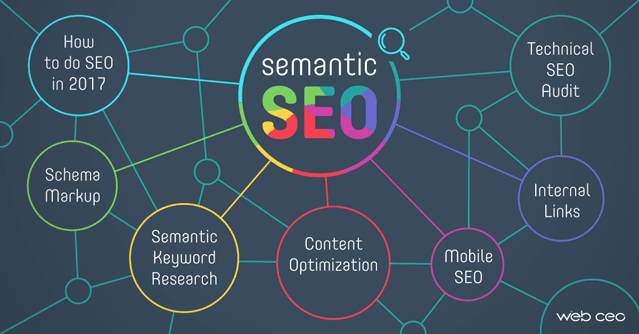Google launched Google Hummingbird in 2013. Hummingbird aims at considering the context and meaning of the keywords that people search on Google. Google wants to get better at understanding the motives and intentions of its users. Hummingbird analyzes the sense of a complete sentence and focuses on the overall search intent of the user. Traditional SEO focused on keywords alone and missed the relationship between various keywords and how they sit in the context. Those days search engines did not take into account the user search intent and provided irrelevant search results. But now SEO based on keywords is dying, and semantic SEO is taking over.
Semantic SEO is a better way to measure your SEO results as it increases the accuracy of your SEO efforts. If you’re not applying semantic SEO techniques to your web pages, you’re at a disadvantage compared to those who are. Semantic SEO helps you create more traffic from Google over a longer period.
What is Semantic SEO?
The recent algorithmic changes focus on topics. Semantic SEO aims at optimizing content based on topicality rather than keywords. You have to optimize content to make sure that you address the underlying need of the user. Writing content for both your audience and for search engines is a futile task. The new algorithms are good at comprehending human language to provide search results based on topics, user intent, and meaning. Understanding the deeper motives of your audience is essential to create content that appeals to them. The modern algorithms rank sites that get better in understanding the user queries and provide satisfactory answers. It punishes those who abuse the system by stuffing content with keywords.
Keyword Ranking – Not the only way to measure success:
SEOs are always trying to rank for keywords. But sometimes, this is not enough. Instead of trying to rank for the most competitive words on the web, it’s important to look at other ways of measuring success (and ranking) for SEO.
The general trend in tracking SEO results is to look at keyword rankings. Keyword rankings are not the only way to measure success. When a site loses rankings, the usual response is to include the self-same keywords everywhere. But this is not a good idea as there are other good reasons for it. The search engines could rank your competitors as they are good at matching their content with user needs. Or it could be due to changes in the algorithm. Losing rankings does not mean all is lost. Your other keywords might still rank and beat your competitors. Your audience is looking for valuable content. If you fulfill the innermost needs of your audience, you will do well in search rankings. Ranking based on keywords is not a good way to measure success. You can get the SEO services of a digital marketing company to help you with optimizing your keywords based on user intent.
Do not forget the Big Picture:
SEO is not once-and-for-all work. With the latest algorithm update, you need to develop new SEO strategies to stay relevant in the marketplace. Rankings are not reliable to measure success, as they will not give you the complete picture. As your competitors fight for the top spot in the Google rankings, you should expect more changes in how sites are ranked. Tracking sales conversions is the best way to measure success. Getting your site ranked on Google is not your ultimate goal. You aim to achieve more traffic to your site that results in sales conversions. Therefore, you should focus on improving your site visibility. Visibility is a better way to measure success, as keyword rankings are only a tiny part of the story. Performance Indicators are more reliable to measure success.
Performance indicators:
Looking at Key Performance Indicators (KPIs) is a better way to tell the success of your SEO.
Lagging Indicators:
Lagging indicators tell you about past performance. You can track the results of SEO on your business. The lagging indicators in SEO are things that give a delayed result. For example, according to Moz, if you submit your website to many popular directories it may put you on the front page of some of those domains. That won’t have visibility from Google for a few days. In the same way, when you submit your website to DMOZ it can take a while to get listed there. Once it does though, you’ll start ranking for quite a few additional keywords.
Some lagging indicators can be used to track the progress of SEO efforts and guide the future direction of SEO activities. Business Growth is a KPI that allows you to track the sales your website gets from SEO efforts. It is better than other indicators, as it gives you information about sales conversions. Lagging indicators is a term being used for those SEO tactics that have been dying out. Lagging indicators can be either your competitor’s lost traffic or a dead end. If you follow a dead end, then there is no way for you to progress further. SEO without lagging indicators is a lack of growth.
Achieving sales & business growth is the ultimate goal of every SEO. Organic traffic gives you data about the number of visitors to your site from search results. More growth in traffic means more sales. Search visibility is another indicator that tracks the number of times a website appears in search results. This indicator helps you bring in more organic traffic to your site. Organic traffic is essential for better user engagement and interaction.
Leading Indicators:
What are the leading indicators in SEO? In a nutshell, they help you track your performance as an SEO as well as provide insights on the health of your domain.
Impressions & Clicks are crucial indicators to track for your SEO strategy. It is an important indicator that helps you to increase user engagement rates. If you want better engagement rates, you can consider purchasing SEO services from a top digital marketing company. Measuring success based on impressions rather than rankings gives you the complete picture of how SEO benefits your business.
Another indicator tells you about the pages and keywords that get indexed in search engines. Another indicator displays keyword rankings and performance. Tracking how particular keywords perform will not give you the complete picture of the success of your SEO. You need to match your keywords with the user intent and then track how those keywords are doing. The higher your intent-based keywords rank, the more successful is your SEO strategy.
leading indicators are signals that, if present on a website, are correlated with higher rankings in Google search results. Leading indicators appear to influence rankings in search results directly, even if the cause is not yet known.
Both leading and lagging indicators are essential to get to the reality of how your site is performing. Keyword rankings are only part of the story. Also, you need to match keywords with buyer intent and track its progress over time. Semantic SEO allows search engines to provide search results that are more relevant and answer their needs. As the search engines become clever, it is time to focus on adding value to people rather than beating the algorithm.





